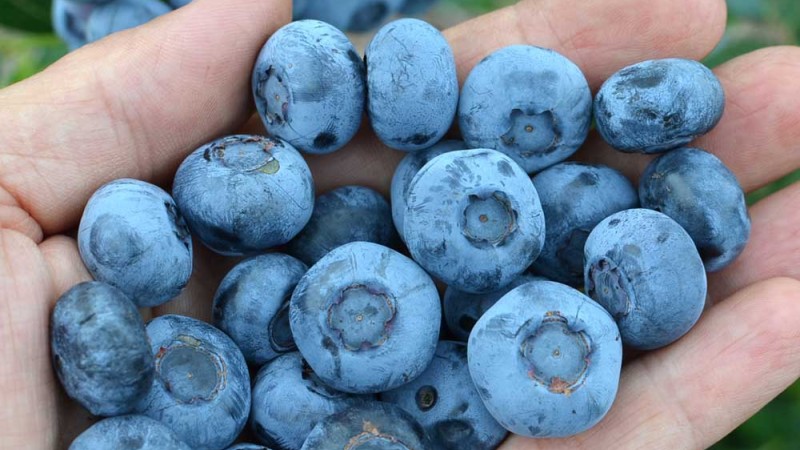
Čučoriedka chocholíkatá (Vaccinium corymbosum) je severoamerický druh čučoriedky, kde sa prirodzene vyskytuje v zalesnených alebo otvorených biotopoch s vlhkými kyslými pôdami. Tvorí opadavý ker dorastajúci do výšky 1,5 – 2 metra. Tmavozelené lesklé listy sú eliptické a dlhé až 5 cm. Na jeseň sa listy sfarbujú do žiarivo červenej, oranžovej, žltej, alebo fialovej farby. Kvitne v polovici mája. Kvety sú zvončekovitého tvaru, bielej až svetloružovej farby. Druh je tetraploidný a nie je samoopelivý. Na tvorbu plodov je potrebné vysadiť viacero odrôd (najmenej dve) aby sa zabezpečilo krížové opeľovanie. Plodom je modročierna bobuľa s priemerom 6,5 – 13 mm. Plody dozrievajú od začiatku júla do konca septembra v závislosti od odrody. Pri optimálnej starostlivosti je možné dosiahnuť úrodu 4-6 kg/ker. Pre úspešné pestovanie je veľmi dôležitý výber stanovišťa. Nevhodné miesto je najčastejšou príčinou problémov pri pestovaní.
Špecifické nároky na pôdu
Čučoriedka vyžaduje ľahkú, dobre priepustnú piesočnato-hlinitú pôdu bohatú na organickú hmotu. Navyše vyžaduje silne kyslú pôdu s pH v rozmedzí pH 3,5 - 4,5. Pôda nesmie byť vysychavá ale nesmie byť ani príliš premokrená. Ak už máte čučoriedku vysadenú, vysoké pH môžete upraviť pravidelným používaním hnojív v síranovej forme (fyziologicky kyslé hnojivá), prídavkom rašeliny, kompostovanej kôry alebo kompostovaných pilín z dreva ihličnatých stromov.
Stanovište a výsadba
Pre maximálnu produkciu je nevyhnutné plné slnečné svetlo po celý deň. Čučoriedky sa zvyčajne vysádzajú vo vzdialenosti najmenej 1,5 metra od seba v radoch vzdialených 2,4 až 3 metre. Rastliny sadíme do jám ktoré sú naplnené vhodným substrátom. Do jamy hnojivo nedávame. Na jednu sadenicu potrebujeme 40 litrov kyslého substrátu. V prípade, že okolitá pôda obsahuje príliš veľa uhličitanov vápnika, potom oddeľte kyslý substrát od okolia plastovou fóliou. Rastliny po výsadbe dôkladne zalejte. Dbajte na to, aby korene čučoriedok počas presádzania nevyschli. Odstráňte slabé a zlomené konáre.
Nároky na zavlažovanie a starostlivosť o rastliny
V našich podmienkach sú čučoriedky plne mrazuvzdorné; počas obdobia vegetačného pokoja znesú mrazy až -29 °C, ale sú citlivé na holomrazy. Voda je jedným z limitujúcich faktorov pri úspešnom pestovaní čučoriedok. Zvlášť po výsadbe a v prvom roku pestovania sú mimoriadne citlivé na nedostatok vody. Najväčšie nároky na vlahu majú v období intenzívneho rastu bobúľ a diferenciácie kvetných pukov, teda v mesiacoch máj až september. Vzhľadom na priepustný pestovateľský substrát v ktorom sa pestujú, rastliny od kvitnutia až po zber úrody podľa potreby rovnomerne a dostatočne zavlažujeme a kontrolujeme trvalé aj jednoročné buriny. Čučoriedky majú plytký koreňový systém a mali by sa mulčovať vrstvou organického mulču s hrúbkou 7 až 10 cm. Dobrým mulčom sú drevené štiepky, kôra, ihličie, listy alebo ich kombinácie. Pred aplikáciou mulču navlhčite pôdu.
Výber správneho hnojiva
Čučoriedky uprednostňujú kyslú pôdu a potrebujú dusík v amónnej forme, nie v dusičnanovej. Vyhnite sa nadmernému hnojeniu, najmä pri nových rastlinách, a zvážte použitie granulovaného hnojiva s pomalým uvoľňovaním. Čučoriedky najlepšie využívajú amónny (NH4+) dusík, preto si vyberte hnojivá ako močovina, síran amónny alebo vyvážené hnojivo špeciálne vyvinuté pre rastliny milujúce kyslé prostredie. Vyhnite sa hnojivám obsahujúcim iba dusičnany (NO3-), pretože môžu byť pre rastliny škodlivé. Pre čučoriedky sú často vhodné hnojivá určené pre azalky a rododendrony. V prvom roku aplikujte hnojivo približne mesiac po výsadbe a rovnomerne ho rozložte okolo rastliny. Túto aplikáciu opakujte o 4-6 týždňov. Pre mladé rastliny je dávka 30 g, pre dospelé rastliny 100-150 g síranu amónneho na rok. V prípade dospelých rastlín hnojte skoro na jar. Druhú dávku hnojiva aplikujte približne o šesť týždňov neskôr na podporu tvorby plodov. Neaplikujte hnojivá po 1. júli, aby ste predišli stimulácii rastu v neskorej sezóne.
Rez
Čučoriedky netrpia významnými chorobami a sú odolné voči škodcom. Rez počas prvých 4 rokov pestovania predstavuje len odstraňovanie slabých, chorých a odumretých výhonov. Presvetľujúci a zmladzovací rez kríkov spravte až v 5-tom roku. Vyrežte najstaršie výhony, na ktorých nie sú mladé plodonosné jednoročné výhonky. Najvhodnejší termín rezu je na konci zimy.
Liečivé účinky čučoriedok
Nezvyčajne vysoký obsah antioxidantov (vrátane vitamínu C) v čučoriedkach pomáha v našom tele budovať ochranný štít pred voľnými radikálmi, vírusmi a baktériami. Čučoriedky sú teda skvelou prevenciou mnohých chorôb, liekom a silným podporným prostriedkom pri rekonvalescencii, chránia naše sliznice a stimulujú ich regeneráciu. Čerstvé, sušené, mrazené alebo inak konzervované čučoriedky sú tým pravým liekom pri všetkých respiračných ochoreniach, pomáhajú liečiť chrípku, angínu, bronchitídu, nádchu a iné infekčné a zápalové ochorenia slizníc. Ďalším úžasným pôsobením je schopnosť zlepšovať a udržiavať náš zrak, čo preukázali aj odborné vedecké výskumy. Ich častá konzumácia je účinnou prevenciou šerosleposti. Ľudia, ktorí majú problémy s nočným videním, pozorujú zlepšenie zraku v zhoršených svetelných podmienkach. Čučoriedky sa už po mnoho generácií používajú ako liečebný prostriedok pri črevných ťažkostiach a kolikách, pri hnačke a otravách jedlom. Tu fungujú ako dezinfekcia. Blahodarný účinok majú aj na obličky a močové cesty, čistia ich a pomáhajú liečiť prípadné infekcie v tejto oblasti. Pôsobia mierne močopudne, zbavujú telo škodlivín a zlepšujú funkciu lymfatického systému. Ozdravný účinok majú tiež na prostatu, hovorí sa o nich dokonca ako o prírodné prevencii rakoviny prostaty, ale aj v súvislosti s prevenciou mnohých iných typov rakoviny.









